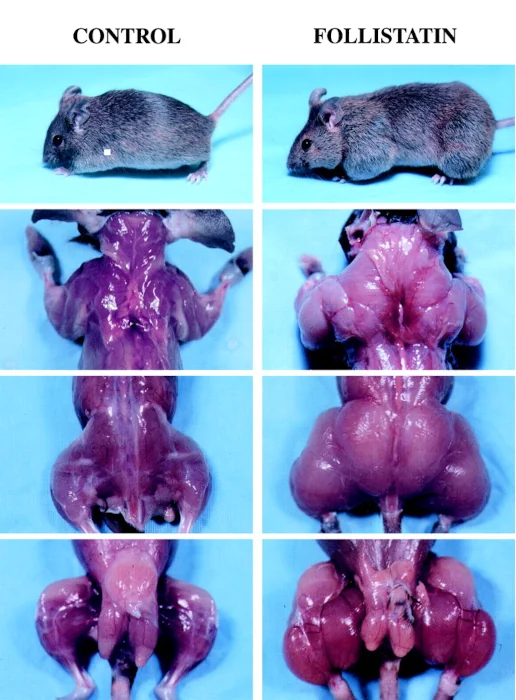In an effort to slow his aging, Bryan Johnson took a follistatin gene therapy on September 5, 2023.
According to his post, the follistatin gene therapy ranks 7th amongst trials in extending the lifespan of mice. It can potentially:
- Reduce epigenetic age
- Increase muscle volume and strength
- Improve organ health

In this article we’ll look at:
- What a follistatin gene therapy is
- Why might Bryan have taken it – the potential benefits
- Is it safe?
- Where can it be purchased?
What Is Follistatin Gene Therapy?
Follistatin’s therapeutic benefits appear to stem from a range of cellular effects.
(Heads up, this section gets a little technical)
Whilst it may be too early to say we fully understand its effects, we can at least point to some key functions.
In particular, is its ability to bind to and inhibit members of what is called the TGF-β superfamily. Specifically:
- Activins – these are proteins involved in processes that regulate cell growth, apoptosis, metabolism, inflammation and more.
- Growth Differentiation Factors (GDFs) – including myostatin, which, when inhibited, will increase muscle size and strength.

It can also bind to Bone Morphogenetic Proteins (BMPs), which participate in bone formation and organ development, and other TGF-β Family Members.
Mice with no follistatin expression have smaller and fewer muscle fibers, stunted growth, skeletal defects, and reduced body mass, which causes them to die within a few hours after birth.1Multiple defects and perinatal death in mice deficient in follistatin | Matzuk, M. M. et al. | 1995 | Nature

Follistatin gene therapy introduces the follistatin gene into the cells to increase the production of this protein.

The administration is intranasal or injectable, and both options are efficient in delivering this gene therapy to multiple organs without causing unwanted side effects, according to a study published in the Proceedings of the National Academy of Sciences (PNAS) journal.2Follistatin Gene Delivery Enhances Muscle Growth and Strength in Nonhuman Primates | Kota, J. et al. | 2009 | Science Translational Medicine That’s why follistatin gene therapy uses FS344 transgene, which encodes for the FS315 form of this protein.

Why Does Bryan Johnson Undergo Follistatin Gene Therapy?
According to Bryan’s tweet, he started follistatin gene therapy for several reasons:
- Epigenetic age reduction
- Monitoring organs for possible improvements
- Increased muscle volume and strengths
- Reduced speed of aging
Here’s how this gene therapy could benefit Bryan’s body:
Epigenetic Age Reduction
Bryan’s team of experts monitors many epigenetic markers because they are crucial for understanding his current biological age. This comprehensive monitoring allows them to assess the impact of follistatin gene therapy on the epigenetic age of cells, providing valuable insights into the potential anti-aging effects.
According to a short Youtube video, the starting levels of follistatin were below ten, and Bryan expected them to be somewhere in the 20s after the intervention.
The first results showed that this gene therapy increased follistatin levels by 160%, successfully achieving that goal.

Monitoring Organs for Possible Improvements
Bryan’s team observes over 30 parameters to assess the comprehensive benefits of follistatin gene therapy on different organs. Here are some examples of what they monitor:
- Cardiovascular system
- Motor nervous system
- Muscles
- Visceral and subcutaneous fat
- Brown and beige fat
- Ligaments, tendons, and cartilage
- Bones
- Kidneys
This close monitoring provides real-time insights into the therapy’s impact on various physiological aspects, allowing his team to adjust or stop the treatment if needed. That ensures safety and effectiveness.
Improved Muscle Volume and Strength
Injecting FS344 in mice results in a long-term increase in muscle mass and strength.3Long-term enhancement of skeletal muscle mass and strength by single gene administration of myostatin inhibitors | Haidet, A. M. et al. | 2008 | Proceedings of the National Academy of Sciences
Follistatin overexpression increases muscle fiber count and diameter, leading to greater skeletal muscle mass in mice by 194 to 327%.4Regulation of myostatin activity and muscle growth | Lee, S.-J. et al. | 2001 | Proceedings of the National Academy of Sciences
Bryan managed to gain 1.5L of muscle in 10 months while following a calorie restriction diet (source). Now that Bryan has increased his calorie intake and started the follistatin gene therapy, he expects even better results.
In the same X post, he mentions that the potential effect of this therapy is superior muscle mass and strength. Considering his current body composition, it will be interesting to see the results he achieves.

Reduced Speed of Aging
In the study published in the PNAS journal that established follistatin gene therapy safety, researchers also determined that it has the potential to increase lifespan in mice by 32.5%. This is probably the study Bryan referenced when he mentioned how this therapy increased lifespan in mice by 30%.
This treatment significantly improved several parameters linked with aging, like glucose tolerance, physical performance, body mass loss, and alopecia. In addition, follistatin gene therapy has managed to slow down mitochondrial structure deterioration.
Translating this research to humans can significantly benefit our quality of life and extend our health span.
Is Follistatin Gene Therapy Safe?
The short answer is that we don’t have the data yet to know.
For the rest of this section, we’re referring specifically to the follistatin mini circle plasmid therapy that Bryan Johnson had administered. Contrasting this with other methods of administering the therapy, such as viral vectors, used in some studies.
Here’s what we do know…
Follistatin gene therapy shouldn’t permanently alter the DNA in the cell’s nucleus. Certainly, to date, there are no reports of this.
It introduces the FS344 transgene into the cell via vector plasmid that then gets translated into the FS315 follistatin protein.
According to Mini Circle Clinic’s own PDF, this therapy has only been performed on around 250 people in the world as of October 2023, so the long-term safety data doesn’t exist yet. However, the manufacturers have included a kill switch that can stop the translation of FS344 transgene at any time.
The company recognizes that follistatin therapy can increase LDL cholesterol. However, the 10 mg/ dL increase is relatively small, considering that normal LDL cholesterol levels in healthy people are below 130 mg/dL.
Using follistatin gene therapy for muscular conditions produced no adverse effects in human subjects.5Follistatin Gene Therapy for Sporadic Inclusion Body Myositis Improves Functional Outcomes | Mendell, J. R. et al. | 2017 | Molecular Therapy

Follistatin could increase the risks of developing certain types of cancer while inhibiting others.6Clinical and Therapeutic Implications of Follistatin in Solid Tumours | Shi, L. et al. | 2016 | Cancer Genomics & Proteomics However, we need more data to understand the complex link between follistatin and cancers.
Because we lack quality long-term safety data, Bryan’s team monitors everything, which could contribute to a better understanding of follistatin gene therapy safety and efficacy.
The great thing about follistatin gene therapy is that it has a kill switch. The company puts a binding spot for antibiotic tetracycline in front of the gene. If anything goes wrong, you can take tetracycline, which stops the protein translation and turns off the entire plasmid.
Companies Offering Follistatin Gene Therapy
Dr. Adeel Khan is one of the leading regenerative medicine experts focusing on stem cell therapies and innovative anti-aging treatments.

He is the chief medical officer for Minicircle, a company that offers the world’s first reversible gene therapy.
The company is currently running a phase I/IIa follistatin gene therapy trial that seeks to determine the full potential of this treatment. Unfortunately, details of this trial are hard to come by. The author (Reason) of the FightAging blog has said he participated it, however, as of Nov 23, he says he can’t share his results until they’re published.
Minicircle’s follistatin gene therapy involves a one-time subcutaneous injection that’s supposed to last for 1.5 years. The treatment price is around $25,000, with the company trying to make it more accessible in the future (source).
Read more about Minicircle’s follistatin gene therapy here.

Dr. Khan is also involved with Eterna, a pioneer in stem cell and gene therapy treatments. Under Dr. Khan’s guidance, Eterna provides follistatin gene therapy. However, the company is not as transparent about the procedure as Minicircle, and you’d need to contact them about all the details.
Conclusion
Bryan Jonhson’s venture into follistatin gene therapy is a bold exploration of the novel anti-aging and longevity approaches.
The therapy’s potential to address epigenetic age reduction, organ improvement, increased muscle volume and strength, and a slowed aging process holds considerable promise for a healthier and potentially longer life.
The ongoing monitoring and safety precautions of Bryan and his team make us excited to see the results and potential positive outcomes of follistatin gene therapy.
References
- 1Multiple defects and perinatal death in mice deficient in follistatin | Matzuk, M. M. et al. | 1995 | Nature
- 2Follistatin Gene Delivery Enhances Muscle Growth and Strength in Nonhuman Primates | Kota, J. et al. | 2009 | Science Translational Medicine
- 3Long-term enhancement of skeletal muscle mass and strength by single gene administration of myostatin inhibitors | Haidet, A. M. et al. | 2008 | Proceedings of the National Academy of Sciences
- 4Regulation of myostatin activity and muscle growth | Lee, S.-J. et al. | 2001 | Proceedings of the National Academy of Sciences
- 5Follistatin Gene Therapy for Sporadic Inclusion Body Myositis Improves Functional Outcomes | Mendell, J. R. et al. | 2017 | Molecular Therapy
- 6Clinical and Therapeutic Implications of Follistatin in Solid Tumours | Shi, L. et al. | 2016 | Cancer Genomics & Proteomics


